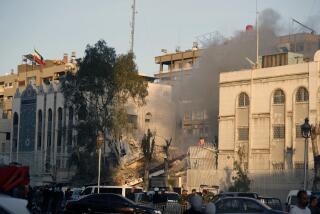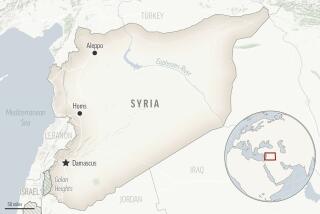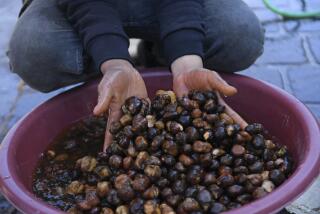Syrian troops roll into Hama, a symbol of antigovernment activity
Syrian tanks, troops and bulldozers on Monday swept into a city that has long been a potent symbol of the nation’s pro-democracy movement, raiding houses and hunting down activists opposed to President Bashar Assad’s rule.
Witnesses and activists said at least three people were killed, including a 12-year-old boy, and dozens injured as security forces stormed into the outskirts of Hama. Hafez Assad, the president’s father and predecessor, brutally crushed an uprising against his rule in the restive city in 1982.
The latest sweep came three days after residents held one of the largest protests in the 3 1/2-month uprising against the regime.
“Security forces blocked the entrances around the city during the night, which made it impossible for people to leave the area,” said Omar Hamwe, a resident and member of the Syrian Local Coordination Committee, a leading protest group.
The government’s raid on Hama, which followed the firing Saturday of the provincial governor amid rumors the official had refused to allow troops to fire on protesters, lent credence to the demonstrators’ contention that Assad’s recent promises of reform were little more than window dressing.
In Hama’s protest hot spots, security forces ambushed worshipers at early-morning prayers, including the elderly, a witness said. Plainclothes and uniformed security forces took turns searching homes and detaining suspects. Armed men broke down doors, entering houses while residents were still asleep.
“Even people severely wounded weren’t spared,” Hamwe said. “The security forces still managed to drag away those who were injured by the attacks.”
Security officials in unmarked cars scoured neighborhoods, intermittently firing live rounds into the air, reported other witnesses who were reached by telephone or Skype and requested anonymity because they feared for their safety.
“The city is currently a ghost town. It is completely dead,” Hamwe said.
Residents fought back, trying to block arrests. In one district, a military sweep was stopped short of a central square by residents who took to the streets at 5 a.m., chanting “God is great” and burning tires. Many of the families threw stones at plainclothes security forces, witnesses said.
In response, the military deployed trucks full of more security personnel and dispatched bulldozers to force open the streets the residents had tried to close off, witnesses reported.
Although the regime’s attempts at crushing the uprising with brute force so far have not appeared successful, some observers worry that the government has managed to split the leadership of the two main opposition camps. The youth wing backing street demonstrations has distanced itself from the older traditional opposition members who have taken part in talks with authorities, described as dialogue efforts.
Longtime activist Michel Kilo, who has participated in the sessions, said the youth owed their elders. “We taught them these slogans,” he said in a phone interview from Damascus, the Syrian capital.
But Rami Nakhle, an opposition activist based in Beirut, criticized the traditional camp for meeting with Assad’s deputies.
“They still have red lines they must not cross,” he said. “Does anyone have the ability to question Bashar’s legitimacy, or to call to account the secret police?”
Nevertheless, he urged both sides to shelve their differences until the regime is toppled.
Others downplayed the growing differences between the two sides.
“Of course the opposition is not united,” said longtime activist Louay Hussein. “Years ago the repression in the country made it difficult for any monolithic opposition to form. The opposition was never united to be separated. It is not shameful to have more than one voice.”
Hajjar is a special correspondent. A special correspondent in Damascus contributed to this report.
More to Read
Start your day right
Sign up for Essential California for news, features and recommendations from the L.A. Times and beyond in your inbox six days a week.
You may occasionally receive promotional content from the Los Angeles Times.






